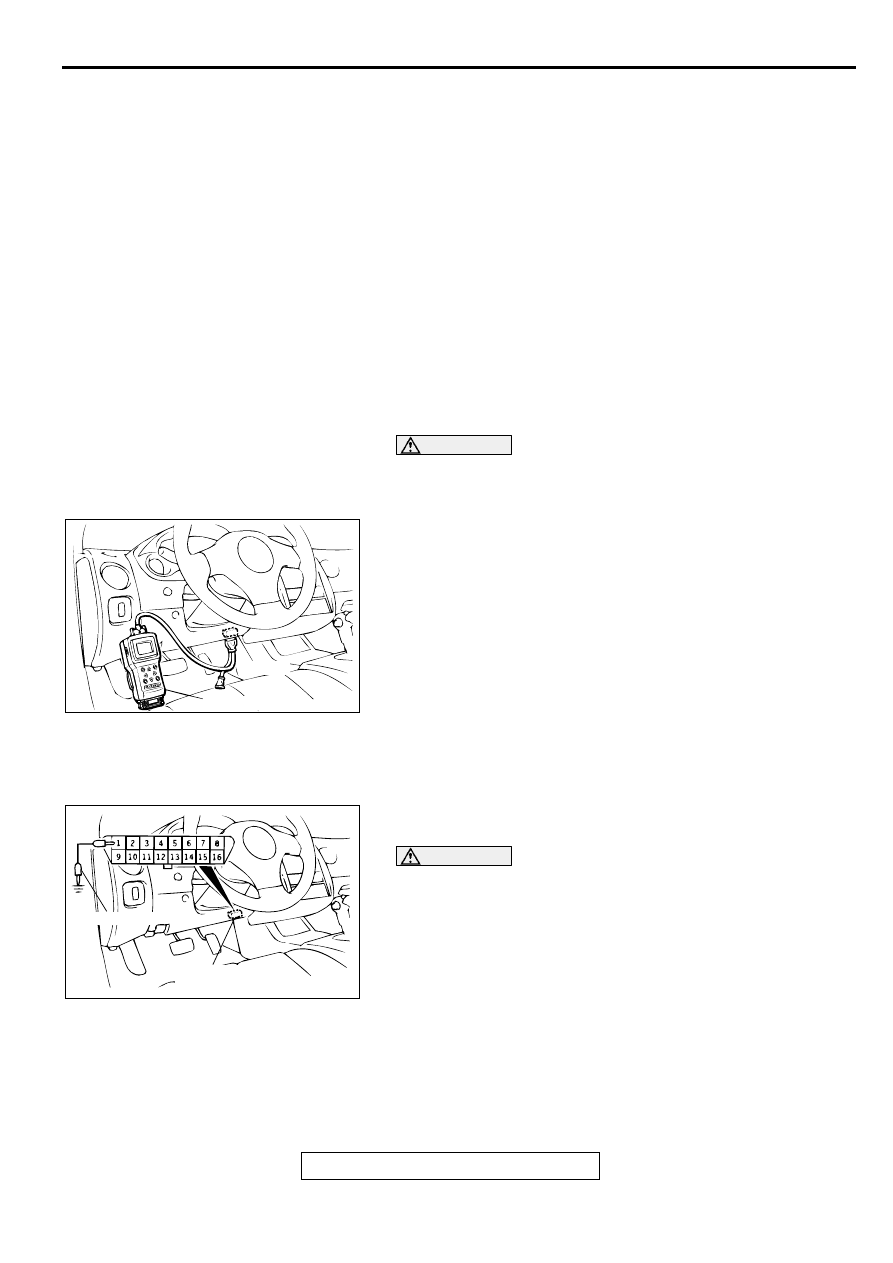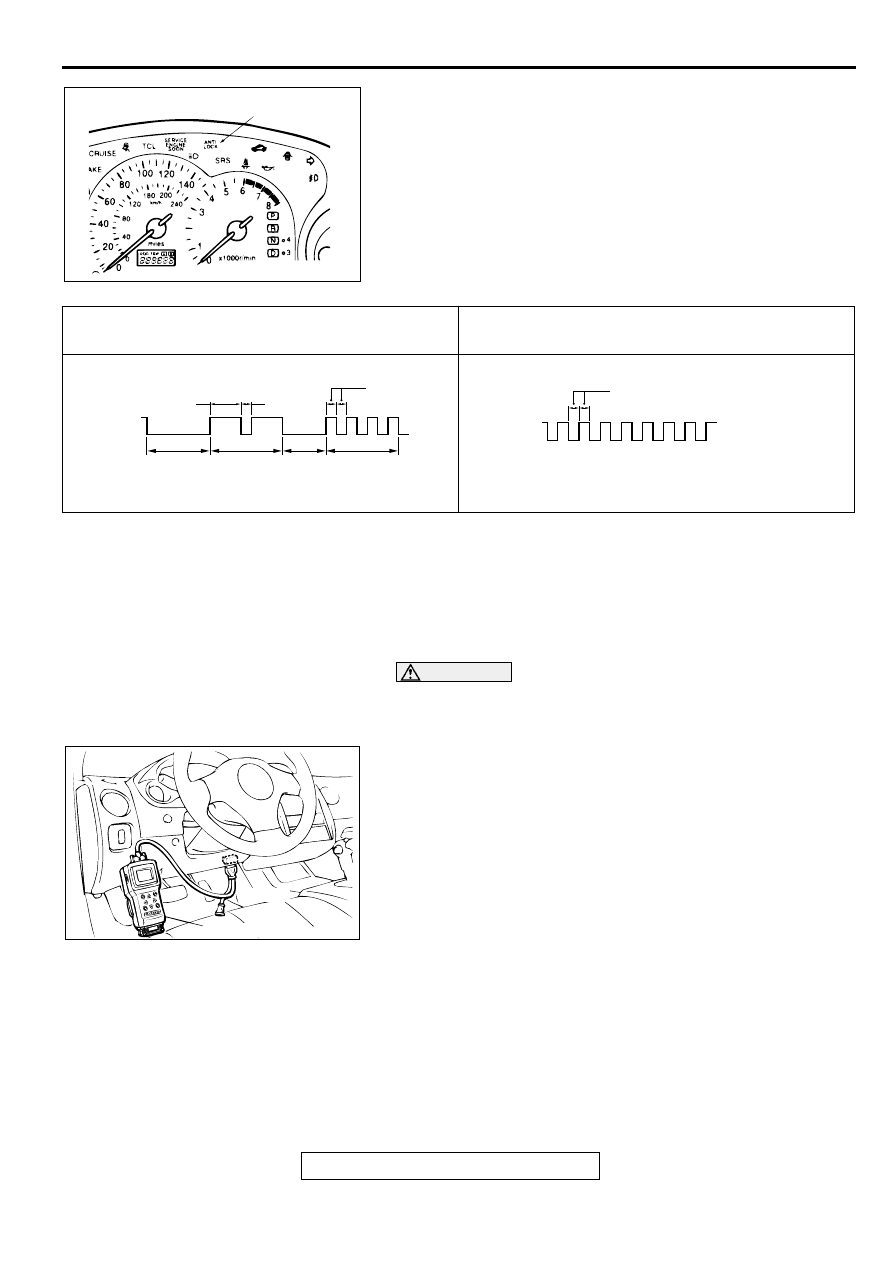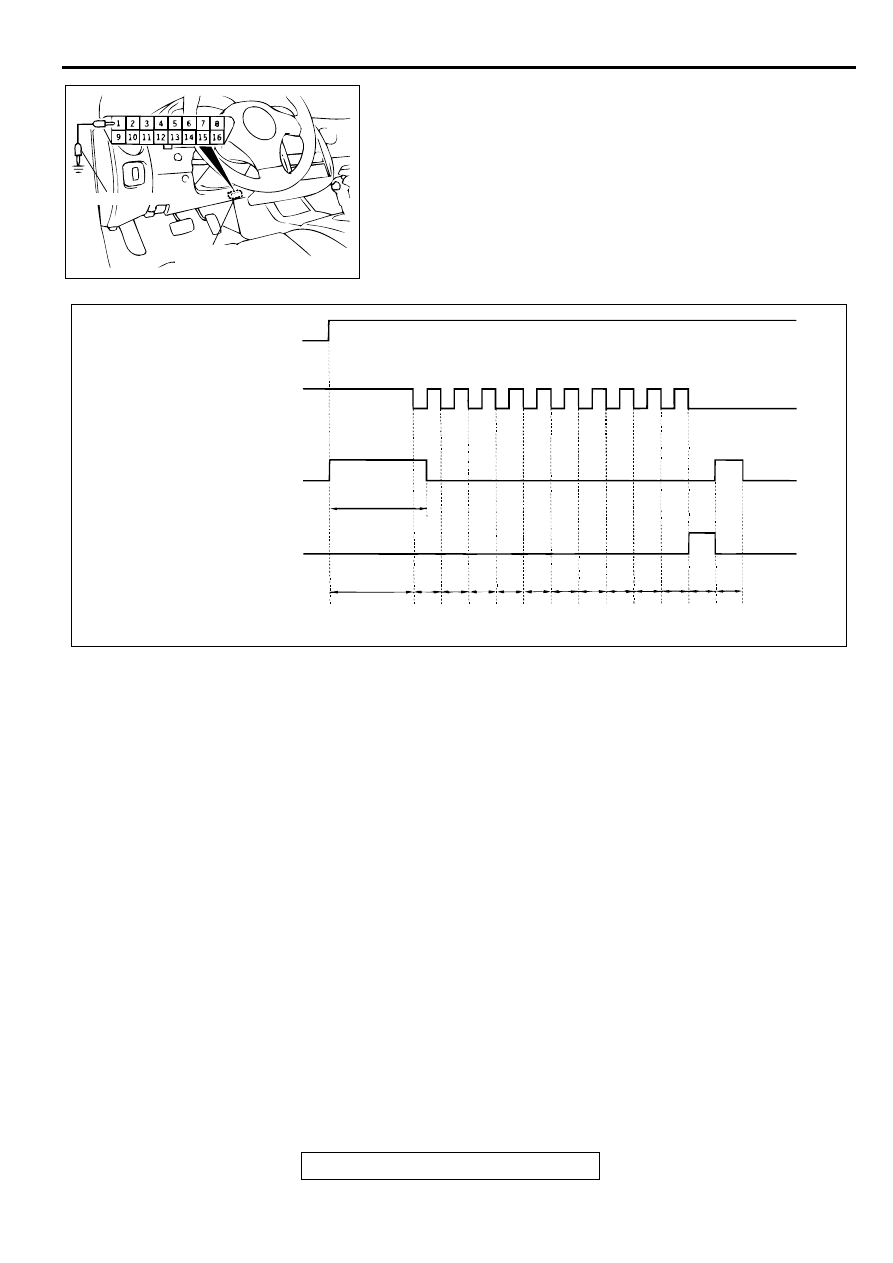Mitsubishi Eclipse / Eclipse Spyder (2000-2002). Service and repair manual — part 578
ANTI-SKID BRAKING SYSTEM (ABS) DIAGNOSIS
TSB Revision
ANTI-LOCK BRAKING SYSTEM (ABS)
35B-3
System Check Sound
When starting the engine, a thudding sound can
sometimes be heard coming from the engine
compartment. This is a normal sound during the ABS
self-check.
ABS Operation Sounds and Sensations
During normal operation, the ABS makes several
sounds that may seem unusual at first:
•
A whining sound is caused by the ABS hydraulic
unit motor.
•
When pressure is applied to the brake pedal, the
pulsation of the pedal causes a scraping sound.
•
When the brakes are applied firmly, the ABS
operates, rapidly applying and releasing the
brakes many times per second. This repeated
application and release of braking forces can
cause the suspension to make a thumping sound
and the tires to squeak.
Long Stopping Distances on Loose Road
Surfaces
When braking on loose surfaces like snow-covered
or gravel roads, the stopping distance can be longer
for an ABS-equipped vehicle than the stopping
distance for a vehicle with a conventional brake
system.
Shock at starting check
Shock may be felt when the brake pedal is lightly
pressed while driving at a low speed. This is a
normal characteristic because the ABS system
operation check is carried out when vehicle speed is
8 km/h (5 mph) or less.
AN TI-SK ID BR AK IN G SYSTEM (A B S) D IA G N O SIS
INTRODUCTION TO ANTI-LOCK BRAKE SYSTEM DIAGNOSIS
M1352012500084
The anti-lock brake system (ABS) operates
differently from conventional brake systems. These
differences include sounds, sensations, and vehicle
performance that owners and service technicians
who are not familiar with ABS may not be used to.
Some operational characteristics may seem to be
malfunctions, but they are simply signs of normal
ABS operation. When diagnosing the ABS system,
keep these operational characteristics in mind.
Inform the owner of the kind of performance
characteristics to expect from an ABS-equipped
vehicle.
ABS Diagnostic Trouble Code Detection
Conditions
ABS diagnostic trouble codes (ABS DTCs) are set
under different conditions, depending on the
malfunction detected. Most ABS DTCs will only be
set during vehicle operation. Some ABS DTCs will
also be set during the ABS self-check immediately
after the engine is started.
When you check if an ABS DTC will be displayed
again after the DTC has been erased, you should
duplicate the ABS DTC set conditions. Depending on
the detection timing and set conditions for the
specific ABS DTC, you must either drive the vehicle
or turn the engine off and restart it. To set the proper
conditions for that DTC again, refer to "ABS DTC
SET CONDITIONS" for each ABS DTC that you are
trying to reset.
ABS DIAGNOSTIC TROUBLESHOOTING STRATEGY
M1352011100072
Use these steps to plan your diagnostic strategy. If
you follow them carefully, you will be sure that you
have exhausted most of the possible ways to find an
ABS fault.
1. Gather information about the problem from the
customer.
2. Verify that the condition described by the
customer exists.
3. Check the vehicle for any ABS DTC.
4. If you cannot verify the condition and there are no
ABS DTCs, the malfunction is intermittent. Refer
to GROUP 00, How to use Troubleshooting/
Inspection Service Points
−
How to Cope with
Intermittent Malfunctions
.
5. If you can verify the condition but there are no
ABS DTCs, or the system cannot communicate
with the scan tool, check that the basic brake
system is operating properly.

ANTI-SKID BRAKING SYSTEM (ABS) DIAGNOSIS
TSB Revision
ANTI-LOCK BRAKING SYSTEM (ABS)
35B-4
•
If the basic brake system is not operating
properly, refer to the GROUP 35A, Basic Brake
System Diagnosis
.
•
If the basic brake system is operating properly,
refer to
6. If there is an ABS DTC, record the number of the
DTC, then erase the DTC from the memory using
the scan tool.
7. Recreate the ABS DTC set conditions to see if the
same ABS DTC will set again.
•
If the same ABS DTC sets again, perform the
diagnostic procedures for the DTC. Refer to
•
If you cannot get the same ABS DTC to set
again, the malfunction is intermittent. Refer to
GROUP 00, How to use Troubleshooting/
Inspection Service Points
−
How to Cope with
Intermittent Malfunctions
ABS TROUBLE CODE DIAGNOSIS
M1352011200080
Retrieving ABS Diagnostic Trouble Codes
Using Scan Tool MB991502
Required Special Tool:
•
MB991502: Scan Tool (MUT-II)
CAUTION
To prevent damage to scan tool MB991502, always turn the
ignition switch to the "LOOK" (OFF) position before
connecting or disconnecting the scan tool MB991502.
1. Connect scan tool MB991502 to the data link connector.
2. Turn the ignition switch to the "ON" position.
3. Use scan tool MB991502 to check for ABS diagnostic
trouble codes.
4. Turn the ignition switch to the "LOOK" (OFF) position.
5. Disconnect scan tool MB991502.
Using the ABS Warning Light and Special Tool MB991529
Required Special Tool:
•
MB991529: Diagnostic Trouble Code Check Harness
1. Use special tool MB991529 to ground number 1 terminal of
the data link connector.
CAUTION
Do not depress the brake pedal after the ignition switch is
turned "ON". If the brake pedal is depressed while the ABS
is inoperative and the ignition switch is "ON", the ABS
warning light will remain on. Because of this, diagnostic
trouble codes will not be read out.
2. Turn the ignition switch to the "ON" position.
AC001252AF
16 PIN
MB991502
AC002241AB
MB991529
DATA LINK
CONNECTOR

ANTI-SKID BRAKING SYSTEM (ABS) DIAGNOSIS
TSB Revision
ANTI-LOCK BRAKING SYSTEM (ABS)
35B-5
3. Read out a diagnostic trouble code by observing how the
warning light flashes.
4. Disconnect special tool MB991529.
Erasing ABS Diagnostic Trouble Codes
Using Scan Tool MB991502
Required Special Tool:
•
MB991502: Scan Tool (MUT-II)
CAUTION
To prevent damage to scan tool MB991502, always turn the
ignition switch to the "LOOK" (OFF) position before
connecting or disconnecting the scan tool.
1. Connect scan tool MB991502 to the data link connector.
2. Turn the ignition switch to the "ON" position.
3. Use scan tool MB991502 to erase ABS diagnostic trouble
codes.
4. Turn the ignition switch to the "LOOK" (OFF) position.
5. Disconnect scan tool MB991502.
By Special Operation for Brake Pedal
Required Special Tool:
•
MB991529: Diagnostic Trouble Code Check Harness
AC004361AB
ABS WARNING LIGHT
WHEN THE DIAGNOSTIC TROUBLE CODE NO. 24
IS OUTPUT
WHEN NO DIAGNOSTIC TROUBLE CODE IS OUT-
PUT
ACX01777
ILLUMINATED
SWITCHED
OFF
PAUSE
TIME 3s
TENS
SIGNAL
PLACE
DIVISION
2s
UNITS
SIGNAL
1.5s
0.5s
0.5s
AB
ACX01778
ILLUMINATED
SWITCHED
OFF
0.25s
AB
AC001252AF
16 PIN
MB991502

ANTI-SKID BRAKING SYSTEM (ABS) DIAGNOSIS
TSB Revision
ANTI-LOCK BRAKING SYSTEM (ABS)
35B-6
1. Use special tool MB991529 to ground number 1 terminal of
the data link connector.
NOTE: If the ABS-ECU functions have stopped due to the
fail-safe function, the diagnostic trouble code cannot be
erased.
2. Depress the brake pedal and hold it.
3. Turn the ignition switch to the "ON" position.
4. After turning the ignition switch to the "ON", release the
pedal within three seconds. Repeat this process of pressing
and releasing the brake pedal 10 continuous times.
5. Turn the ignition switch to the "LOOK" (OFF) position.
6. Disconnect special tool MB991529.
AC002241AB
MB991529
DATA LINK
CONNECTOR
AC000937
IGNITION SWITCH
ON
OFF
STOPLIGHT SWITCH
ON
OFF
ABS WARNING LIGHT
ON
OFF
DIAGNOSTIC TROUBLE
CODE MEMORY
3 s
WITHIN
3 s
WITH-
IN 1 s
WITH-
IN 1 s
WITH-
IN 1 s
WITH-
IN 1 s
WITH-
IN 1 s
WITH-
IN 1 s
WITH-
IN 1 s
WITH-
IN 1 s
WITH-
IN 1 s
WITH-
IN 1 s
1 s
1 s
ERASING
COMPLETED
AB
1ST
2ND
3RD
4TH
5TH
6TH
7TH
8TH
9TH
10TH

Нет комментариевНе стесняйтесь поделиться с нами вашим ценным мнением.
Текст